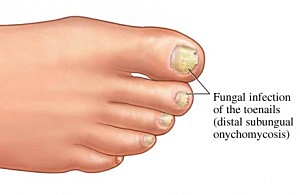Our Podiatrists in Sun City Center & St Petersburg, FL can help with your toenail problems and skin conditions
FUNGAL INFECTION - TOENAIL FUNGUS
Many people don’t realize they have a fungal nail problem. Moreover, many people that do never seek treatment. Still, fungal toenail infections are a common foot health problem.
Fungal toenail infections can persist for years without ever causing pain. The disease, characterized by a change in a toenail’s color, is often considered nothing more than a mere blemish, but it can present serious problems if left untreated.
Also referred to as Onychomycosis, fungal nail infections are an infection underneath the surface of the nail, which can also penetrate the nail. In addition to causing difficulty and pain when walking or running, fungal nail infections are often accompanied by a secondary bacterial and/or yeast infection in or about the nail plate.
A group of fungi called dermatophytes easily attack the nail, thriving off keratin, the nail’s protein substance. When the tiny organisms take hold, the nail may become thicker, yellowish-brown or darker in color, and foul smelling. Debris may collect beneath the nail plate, white marks frequently appear on the nail plate, and the infection is capable of spreading to other toenails, the skin, or even the fingernails.
Nail bed injuries may make the nail more susceptible to all types of infection, including fungal infection. Those who suffer chronic diseases, such as diabetes, circulatory problems, or immune-deficiency conditions, are especially prone to fungal nails. Other contributory factors may be a history of Athlete’s foot and excessive perspiration.
You can prevent fungal nail infections by taking these simple precautions:
Exercise proper hygiene and regularly inspect your feet and toes.
Keep your feet clean and dry.
Wear shower shoes in public facilities whenever possible.
Clip your nails straight across so that the nail does not extend beyond the tip of the toe.
Use a quality foot powder – talcum, not cornstarch – in conjunction with shoes that fit well and are made of materials that breathe.
Avoid wearing excessively tight hosiery, which promotes moisture. Socks made of synthetic fiber tend to “wick” away moisture faster than cotton or wool socks, especially for those with more active life styles.
Disinfect home pedicure tools and don’t apply polish to nails suspected of infection.
Depending on the type of infection you have, over-the-counter liquid antifungal agents, while sometimes effective, may not prevent a fungal infection from recurring. A topical or oral medication may need to be prescribed, and the diseased nail matter and debris removed by a process called debridement.
In some cases, surgical treatment is prescribed, during which the infected fungal nail is removed. Permanent removal of a chronically painful nail, which has not responded to any other treatment, permits the fungal infection to be cured, and prevents the return of a deformed nail.
KERYFLEX NAIL RESTORATION
From Ugly to Beautiful in 15 Minutes
For a variety of reasons, some people are much more likely to develop toenail fungus and other conditions that cause the nail to lose its natural appearance. While medications and laser treatment are available to treat the fungus, the treatments may take some time to be effective and may never restore the nail to its normal appearance.
KeryFlex is durable, yet flexible nail restoration, which creates a realistic, natural looking nail in place of the damaged nail. Since KeryFlex is nonporous and not water soluble, it is ideal for post laser treatment for toenail fungus to prevent re-infection while the healthy nail is growing. Women may put nail polish on this new nail and use nail polish remover on the nail without damaging the nail replacement resin. Men and women can engage in their normal exercise routine after toe nails have been remodeled by KeryFlex.
KeryFlex can also be used to restore a chronic ingrown toenail before considering a surgical treatment.
In as little as 15 minutes, your podiatrist can create a realistic, natural-looking nail in place of a damaged nail. They do this by using the KeryFlex nail restoration system. KeryFlex nails are durable and flexible and you will leave the office with a natural-looking nail.
How Does KeryFlex Work?
Nail bed is prepared, with debridement of the nail
KeryFlex Bond is brushed onto the nail plate and nail bed
KeryFlex Resin builds up the nail and allows sculpting and contouring of the nail
KeryFlex Seal is applied after the modeling process is completed
Ultraviolet light hardens the substances within 2 minutes
Would you like to know more? Click here to make an appointment today.
INGROWN TOENAILS
Ingrown toenails often are the result of trimming your toenails too short, particularly on the sides of your big toes.
While they are very common, ingrown toenails can also be very painful. When trimming your nails, avoid tapering the corners so that the nail curves with the shape of your toe. The sides of the nail will curl down and dig into your skin. Shoes that are too tight or short also may cause ingrown toenails.
Ingrown toenails start out hard, swollen and tender, and later, may become sore, red and infected. Your skin may start to grow over the ingrown toenail.
Soaking your foot in warm, soapy water several times each day is usually a good way to treat an ingrown nail. We recommend that you visit our offices and let Dr. Sanchez and Dr. Cook determine the best course of treatment for your condition.
Antibiotics are sometimes prescribed if an infection is present. Part of your ingrown toenail (partial nail plate avulsion) may need to be surgically removed if an acute infection occurs. The procedure involves injecting the toe with an anesthetic and cutting out the ingrown part of the toenail.
You can prevent ingrown toenails by:
Trimming your toenails straight across with no rounded corners.
Ensuring that your shoes and socks are not too tight.
Keeping your feet clean at all times.
ATHLETE'S FOOT
Learn about athlete's foot treatment options
Athlete’s foot is a skin disease caused by a fungus, usually occurring between the toes. The fungus usually attacks the feet because shoes create a warm, dark, and humid environment that encourages fungus growth.
The warmth and dampness of areas around swimming pools, showers, and locker rooms, are also breeding grounds for fungi. Not all fungus conditions lead to athlete’s foot, however. Other conditions, such as malfunctions of the sweat mechanism, reaction to dyes or adhesives in shoes, eczema, and psoriasis, also may mimic athlete’s foot.
Symptoms of athlete’s feet include drying skin, itching scaling, inflammation, and blisters. Athlete’s foot may spread to the soles of the feet and to the toenails, and can spread to other parts of the body, including the groin and underarms.
You can prevent athlete’s foot by:
Avoiding walking barefoot. Use shower shoes.
Reducing perspiration by using talcum powder.
Wearing light and airy shoes.
Wearing socks that keep your feet dry, and changing them frequently if you perspire heavily.
While fungicidal and fungistatic chemicals are usually used to treat athlete’s foot problems, they often fail to contact the fungi in the lower layers of the skin. Instead, our practice may prescribe topical or oral antifungal drugs.
FOOT WARTS - PLANTAR WARTS
Foot Warts (Plantar Warts) are a common foot condition that we treat in our practice. If you have one or more growths on the bottom of your foot that may or may not be painful, chances are it's a plantar wart.
Plantar Warts are caused by a virus. You may notice little black dots in the wart. People sometimes think these dots are splinters. They are actually the blood vessels that nourish the wart. You can get viral warts anywhere you walk barefoot, such as the local pool, karate studio, dance studio, locker room or even from a pedicure salon.
There are several treatments for plantar warts, the type of treatment received depends upon the patient's needs. Plantar warts can spread easily. If you think you have one or more plantar warts, come in immediately to have them removed before they multiply



